Didactic game “Vegetables and fruits”
The purpose of the didactic game “Vegetables, Fruits” is to form an idea about garden and vegetable plants, the place and method of their growth, to consolidate in memory the correct names of fruits, to develop the ability to distinguish vegetables from fruits by external signs.
The middle group of kindergarteners plays an educational game.
For the lesson, you need to prepare models of trees and garden beds from dense material, and cut out recognizable images of fruits and vegetables.
The teacher lays out pictures of fruits in front of the children, asks them to name them, tell where they grow - on trees or garden beds. The students’ task is to correctly determine the place where the crop grows, attach it to a fake tree or place it on a garden bed.
Another version of the game is possible: the teacher places all the pictures on the tree, asks the children whether all the fruits are hanging correctly and which ones need to be moved to the garden.
For the older group of kindergarteners, you can complicate the task by offering:
- separate fruits and root vegetables by color;
- name the geometric shape of vegetables and fruits;
- ask what can be put in a dessert vase and what can be used to make a salad.
Card index of didactic games about vegetables and fruits.
Card index of didactic games about vegetables and fruits
"Tops and Roots"
Target:
To consolidate the knowledge that vegetables have edible roots - roots and fruits - tops, some vegetables have both tops and roots edible; practice assembling a whole plant from its parts.
Game rules. You can look for your top or spine only when given a signal. You can’t pair up with the same player all the time; you have to look for another pair.
Game actions. Search for a pair; composition of a whole plant.
Progress of the game.
Option 1.
After harvesting the crops in his garden, the adult gathers the children, showing them what a good harvest they have grown, and praising them for their useful work. Then he clarifies the children’s knowledge that some plants have edible roots - roots, others have fruits - tops, and some plants have both tops and roots edible. An adult explains the rules of the game: “Today we will play a game called “Tops and Roots.” On our table are the tops and roots of plants—vegetables. We will now divide into two groups: one group will be called tops, and the other will be called roots. (Children are divided into two groups.) There are vegetables on the table; The children of the first group take the top in their hands, and the children of the second group take the spine. Have you taken everything? And now, at the signal (clap your hands), you will all scatter around the area and run in all directions. When you hear the signal “One, two, three - find your pair!”, quickly find a pair for yourself: the spine to your top. The game is repeated, but you have to look for another top (or spine). You can't be paired with the same player all the time. Option 2. The tops (or roots) stand still. Only one subgroup of guys is running around the site. The adult gives the signal: “Roots, find your tops!” Children should stand so that the tops and roots form one whole.
«Vegetables and fruits»
Goal: to form children’s understanding of vegetables and fruits
.
Form an idea of where they grow. Learn to distinguish them. Fix the names of vegetables and fruits
.
Enrich and develop vocabulary. Learn to correctly name the names of fruits and vegetables
.
Equipment: model of tree and beds, figurines of vegetables and fruits
.
Progress of the game:
fruits and vegetables on it.
.
The child must name the fruits located on the tree. Then he must answer the teacher’s question, which of them grow on trees and which do not. You can also ask the child where, in his opinion, the rest of the fruits grow. The child answers. The child himself must correctly determine where it grows ( fruit or vegetable )
and attach it to the place where it grows
(on the crown of a tree or in a garden bed)
.
"Who will collect it sooner"
Target -
teach children to group vegetables and fruits, develop quick reaction to the teacher’s word, endurance, and discipline.
Game rule
. Collect vegetables and fruits only in accordance with the icon on the basket (on one there is a picture of an “apple”, on the other “a cucumber”). The team that collects all the items in the basket faster without making a mistake wins.
Game actions.
Search for objects, team competition.
Progress of the game.
When addressing children, the teacher reminds them that they already know many vegetables and fruits. “And now we will compete to see whose team can harvest the crop the fastest. Here in this basket (points to the picture “apple” or the “Garden” model) you need to collect fruits, and in this one (where the “cucumber” is drawn - the “Vegetable Garden” model) vegetables. Whoever thinks that they have collected everything lifts the basket like this. We will all check later to see if they forgot anything in the garden or vegetable garden.” The teacher and the children lay out fruits and vegetables on the floor (or area). Two teams are selected: vegetable growers and gardeners (two or three people each). At the teacher’s signal (cotton), children collect vegetables and fruits in the appropriate baskets. The team that picks up the basket first wins (you need to check if the players made a mistake and if the wrong vegetable or fruit went into the basket). After this, the winning team is announced. The game continues with other teams.
“Describe it, and I’ll guess”
Target:
Teach children to classify vegetables and fruits according to their characteristics.
Exercise:
highlight and name the characteristic features of the object in response to the teacher’s questions.
Game action:
asking the teacher riddles.
Game rules:
You cannot name what is being described. Answer the teacher's questions clearly and definitely.
Material:
Vegetables and fruits are laid out on the table. The teacher's chair is placed. so that the plants are not visible to him.
Progress:
“Of the vegetables that are on the table, choose one. I will ask what he is like, and you answer. Just don't say its name. I’ll try to guess from your answers.”
Whose seeds?
Didactic task
: Exercise children in differentiating vegetables, fruits and their seeds. Develop voluntary memory, concentration, observation.
Game rules:
Place the seeds on the corresponding cards with pictures of fruits and vegetables.
Game action:
Children take the seeds they like, name them and place them on the corresponding fruit or vegetable card.
Didactic material:
plates with seeds: pumpkin, peas, sunflower seeds, tomatoes, plums, cherries, watermelon, etc.
Progress of the game
Children are given plates with seeds. They must place the seeds on cards with the appropriate vegetable: zucchini, watermelon, peas, tomato, cucumber, etc.
“Where does it grow?”
Target:
teach children to group vegetables and fruits, develop quick reaction to the teacher’s word, endurance, and discipline.
Rules of the game:
sort out the vegetables and fruits, and put some in the garden, others in the garden (imitation - pictures of a garden and vegetable garden). The team that quickly puts all the items in their places wins.
Progress of the game:
The children are divided into two teams: vegetable growers and gardeners. Vegetables and fruits (dummies can be used) are laid out on the table. At the teacher’s signal, children sort vegetables and fruits into the ones corresponding to the pictures. The team that finishes the job first wins. Children not participating in the teams check the correctness of the selection.
After this, the winning team is announced. The game continues with other teams.
"Vegetable store"
Target:
To develop and consolidate children’s knowledge about the external signs and characteristics of vegetables and fruits, their external signs for storage and preparation, and methods for preparing them.
Material:
Planar image of jars for pickling and compotes, barrels for sourdough, storage boxes, freezer. Sets of small cards with vegetables, fruits and berries.
Progress of the game:
Each child has a set of small cards with vegetables, fruits and berries. Divide the children into teams (depending on the number of children). Each team makes its own “preparations” from its own vegetables, fruits and berries.
Or, from the total number of small cards, teams (salt, ferment, fold for storage) choose for which preparations certain vegetables, fruits and berries are needed
"Tops and Roots"
To consolidate knowledge about the way cultivated plants grow, you can play an outdoor game, for which you will need dummies or images of garden and garden fruits.
The teacher shows the picture, the children name the depicted fruit. When asked where it grows, they answer with physical actions:
- on a tree (fruit) - stretch their arms up;
- on the ground (vegetables) - stretch their arms forward;
- underground (root crops) – squat.
Guess by description
A didactic game about fruits and vegetables is built in the form of questions and answers. The teacher names the signs, asks what vegetable he described, and the children must guess and answer. For example:
- red, round, juicy, fleshy (tomato);
- sharp, hot, white inside, with a yellow husk, with thin leaves (onions);
- green, oval, crispy, covered with pimples (cucumber);
- large, round, orange, with a thick crust, with healthy seeds (pumpkin);
- long, triangular, orange, grows in the ground, with curly greenery (carrot).
Didactic games “Vegetables” for children of senior preschool age
Elena Chuvilina
Didactic games “Vegetables” for children of senior preschool age
Didactic games on the topic “Vegetables” for children 5-7 years old.
1. Didactic game “Whose shadow?”
Target:
develop the ability to find silhouettes of vegetables; learn to name vegetables correctly; learn to distinguish between the concepts of “vegetables”.
Equipment: cards with images of vegetables and their silhouettes.
Option 1. The teacher gives the children color pictures of vegetables. We invite the children to look at them and name them correctly. Next, the teacher shows cards with the shadow of a vegetable. Children must find the right vegetable from the available ones.
Option 2. On one side of the magnetic board we lay out silhouettes of vegetables, on the other - pictures of the vegetables themselves. The teacher suggests attaching pictures of vegetables and their shadows next to each other.
2. Didactic game “What is planted in the garden”
Target:
teach children to classify objects according to certain characteristics (by the place of their growth, by the method of their use, to develop speed of thinking, auditory attention, speech skills.
Game rule. You only need to answer the driver’s questions with “yes” or “no.”
Game action. Whoever makes a mistake gives a forfeit, which he then wins back.
Progress of the game. The teacher asks: “Children, do you know what they plant in the garden? Let's play this game: I will name different objects, and you listen carefully.
If I name something that is planted in the garden, you will answer “yes,” but if something that does not grow in the garden, you will say “no.” Whoever makes a mistake loses.” Educator. Carrot. Children. Yes!
Educator. Cucumbers. Children. Yes!
Educator. Beet. Children. Yes!
Educator. Plums. Children. No!
If someone is in a hurry and answers incorrectly, the teacher can say:
“If you hurry, you will make people laugh. Be careful.
3. Didactic game “Wonderful bag”
Target:
improve the ability to identify a vegetable by touch by its shape, correctly name its color, develop attention, memory, oral speech
Attributes: bag, dummies of vegetables.
Progress of the game: the teacher shows the bag and says:
I am a wonderful bag
I am a friend to all the guys.
I really want to know
How do you like to play?
Children put fake vegetables into a bag. Then, one by one, they take an object from the bag, determine by touch what it is, name it, and then take it out.
4. Didactic game “Tops and Roots”
Target:
Develop the ability to independently recognize vegetables, name them correctly and assemble a whole from parts.
Equipment: Cards with images of vegetables cut into pieces.
Game option: The teacher invites the children to collect pictures of vegetables from two parts “tops and roots.” You must first familiarize the children with the collected pictures so that the children have an idea of what vegetables look like underground and on the surface of the earth.
5. Didactic game “Name as many signs as possible”
(agreement of nouns with adjectives).
Carrots (what kind) - orange, long, sweet, healthy, hard
tomato (what kind) - red, juicy, appetizing, round
Cucumber (what kind) - oval, crispy, green, long, fragrant
6. Didactic game “Potato”
Target:
learn to compose sentences with a specific verb. To consolidate children's knowledge about the work of adults in gardens and fields.
Children are invited to remember the work of vegetable growers. Then come up with a sentence with the given word - action.
Digging In the spring, they dig up the ground to plant potatoes.
Care In order for a good harvest to grow, the plantings must be looked after.
Water In summer the sun is very hot, so you need to water the plants.
Pull out Weeds must be pulled out so that they do not interfere with the growth of potatoes.
Loosen
Dig
Prepare
7. Didactic game “Big - small”
Word formation using diminutive suffixes:
cucumber - cucumber, tomato - tomato, etc.







